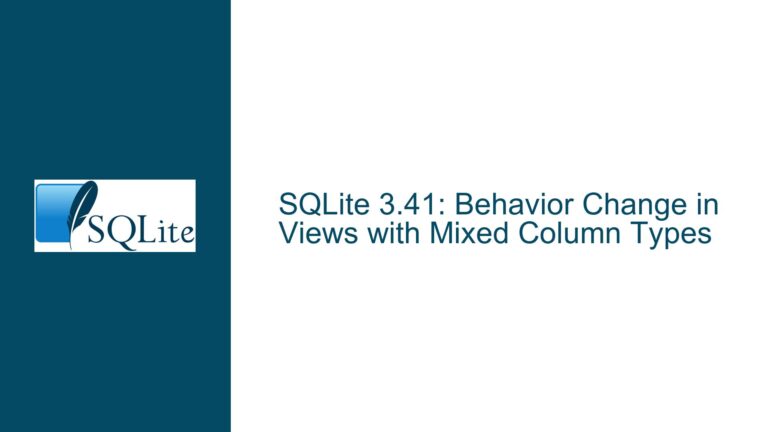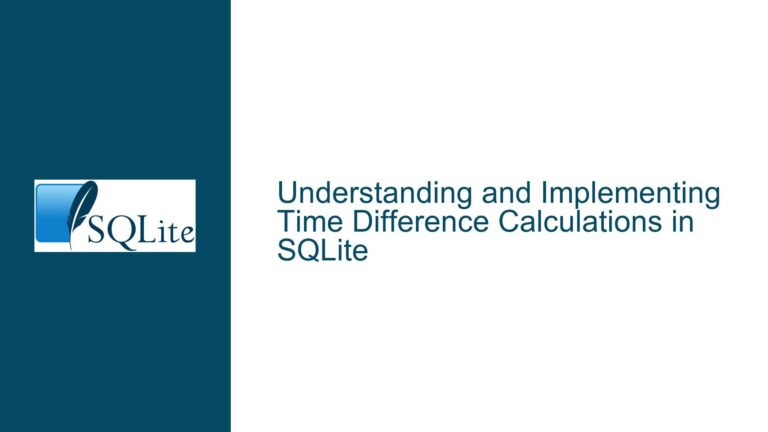Combining JSON Data from Separate Objects in SQLite: A Troubleshooting Guide
Extracting and Combining JSON Data from Multiple Objects in SQLite
SQLite is a powerful, lightweight database engine that supports JSON data manipulation through its json_extract and json_tree functions. However, combining data from separate JSON objects into a single query can be challenging, especially when dealing with nested structures or multiple JSON paths. This guide will explore the nuances of extracting and combining JSON data from multiple objects in SQLite, focusing on a scenario where gas and electricity readings are stored in separate JSON objects within the same database.
Understanding the JSON Structure and Query Requirements
The core issue revolves around extracting data from two separate JSON objects ($.IP15 and $.IP22) within a single database table. Each object contains distinct readings (gas and electricity) along with corresponding timestamps. The goal is to combine these readings into a single query result, ensuring that the data is aligned correctly and efficiently retrieved.
The JSON structure in the database appears to be nested, with each object ($.IP15 and $.IP22) containing key-value pairs for readings and timestamps. For example:
$.IP15containsGas_readingandiso(timestamp).$.IP22containsElectricity_readingandiso(timestamp).
The challenge lies in formulating a query that extracts and combines these readings into a unified result set. The initial approach involved two separate queries, which, while functional, are inefficient and do not align the data as required.
Challenges in Combining JSON Data from Separate Objects
Combining JSON data from separate objects in SQLite presents several challenges:
- Data Alignment: Gas and electricity readings may not have a direct relationship or shared identifier in the JSON structure. This makes it difficult to align the readings in a single result set.
- Query Complexity: Using
json_extractandjson_treefunctions requires careful handling of JSON paths and object types. Misalignment in paths or incorrect filtering can lead to incomplete or incorrect results. - Performance Considerations: Extracting and combining data from nested JSON objects can be resource-intensive, especially if the JSON structure is large or deeply nested.
- Result Formatting: The desired output format (e.g., aligning gas and electricity readings side by side) may not be straightforward to achieve with standard SQLite functions.
These challenges highlight the need for a robust query design that addresses data alignment, performance, and result formatting.
Crafting a Unified Query for Combined JSON Data
To address the challenges, we can use a combination of json_extract, json_tree, and SQLite’s UNION ALL operator. The UNION ALL operator allows us to combine the results of two queries into a single result set, preserving the structure of each query’s output.
Here’s a step-by-step breakdown of the solution:
Extracting Gas Readings:
The first part of the query extracts gas readings and their corresponding timestamps from the$.IP15object. Thejson_extractfunction is used to retrieve theGas_readingandisovalues, whilejson_treeensures that only JSON objects are processed.SELECT 'gas' AS reading_type, json_extract(value, '$.Gas_reading') AS reading, json_extract(value, '$.iso') AS time FROM DATABASE, json_tree(DATABASE.data, '$.IP15') WHERE type = 'object' AND json_extract(value, '$.Gas_reading');Extracting Electricity Readings:
The second part of the query extracts electricity readings and their corresponding timestamps from the$.IP22object. Similar to the gas readings,json_extractretrieves theElectricity_readingandisovalues.SELECT 'electric' AS reading_type, json_extract(value, '$.Electricity_reading') AS reading, json_extract(value, '$.iso') AS time FROM DATABASE, json_tree(DATABASE.data, '$.IP22') WHERE type = 'object' AND json_extract(value, '$.Electricity_reading');Combining Results with
UNION ALL:
TheUNION ALLoperator combines the results of the two queries into a single result set. This approach ensures that both gas and electricity readings are included in the output, with areading_typecolumn indicating the source of each reading.SELECT 'gas' AS reading_type, json_extract(value, '$.Gas_reading') AS reading, json_extract(value, '$.iso') AS time FROM DATABASE, json_tree(DATABASE.data, '$.IP15') WHERE type = 'object' AND json_extract(value, '$.Gas_reading') UNION ALL SELECT 'electric' AS reading_type, json_extract(value, '$.Electricity_reading') AS reading, json_extract(value, '$.iso') AS time FROM DATABASE, json_tree(DATABASE.data, '$.IP22') WHERE type = 'object' AND json_extract(value, '$.Electricity_reading');Aligning Data in the Application Layer:
While the query combines the readings into a single result set, aligning gas and electricity readings side by side (as shown in the desired output) may require additional processing in the application layer. This is because SQLite does not natively support pivoting or complex result formatting.For example, the application can iterate through the combined result set and group readings by their timestamps, ensuring that gas and electricity readings are displayed side by side.
Optimizing the Query for Performance and Scalability
To ensure the query performs well, especially with large datasets, consider the following optimizations:
- Indexing JSON Columns: If the JSON data is stored in a dedicated column, ensure that the column is indexed to speed up
json_extractandjson_treeoperations. - Filtering Early: Apply filters (e.g.,
type = 'object') as early as possible in the query to reduce the number of rows processed. - Limiting Results: Use
LIMITandOFFSETclauses to retrieve results in smaller batches, reducing memory usage and improving response times. - Caching Results: If the data does not change frequently, consider caching the query results to avoid repeated processing.
Alternative Approaches and Considerations
While the UNION ALL approach is effective, there are alternative methods to achieve similar results:
- Using Joins: If the gas and electricity readings share a common identifier (e.g., a timestamp or device ID), a join operation can align the readings in a single query. However, this requires a shared identifier in the JSON structure.
- Custom Functions: SQLite supports user-defined functions (UDFs). A custom function could be written to extract and combine JSON data more efficiently.
- Preprocessing JSON Data: If the JSON structure is complex or deeply nested, consider preprocessing the data (e.g., flattening the JSON) before querying it in SQLite.
Best Practices for Working with JSON in SQLite
- Validate JSON Data: Ensure that the JSON data is valid and well-formed before querying it. Invalid JSON can lead to errors or unexpected results.
- Use Explicit Paths: When using
json_extract, specify explicit JSON paths to avoid ambiguity and ensure accurate data retrieval. - Test Queries Thoroughly: Test queries with different JSON structures and datasets to ensure they handle edge cases and variations in the data.
- Document JSON Schemas: Maintain documentation of the JSON schema and structure to simplify query design and troubleshooting.
By following this guide, you can effectively extract and combine JSON data from separate objects in SQLite, ensuring accurate and efficient results. Whether you’re working with gas and electricity readings or other JSON-based data, these techniques will help you navigate the complexities of JSON manipulation in SQLite.






